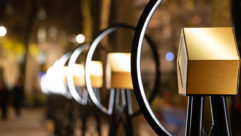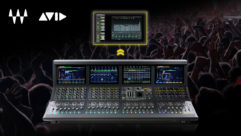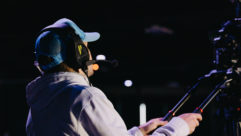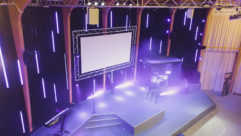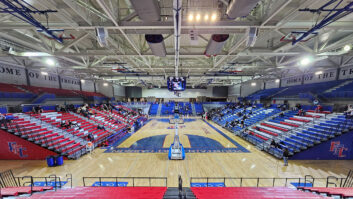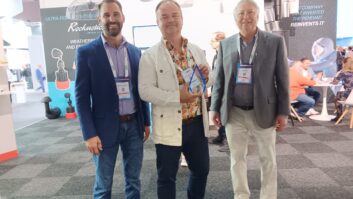
Church Adds Seamless AV
A fast-growing church transforms its original 300-seat facility into a media-savvy chapel without calling undue attention to technology.
Hiding the AV equipment at Leawood, KS-based Church of the Resurrection created several technical challenges, but the result is a media-rich experience in a simple, elegant chapel.
CHALLENGE: Hide installed AV system components within a bare-bones environment and address daylight and reflective surface issues.
SOLUTION: Design and install an unusually tight-packed speaker cluster, carefully hidden projection and recording equipment, and wireless mics into a simple design aesthetic.
WITH ITS new 3,200-seat sanctuary operating in full swing, Leawood, KS-based Church of the Resurrection sought to reconfigure its original 300-seat facility as a chapel for weddings, funerals, baptisms, and regular early-bird services.
Architect Anthony Wilks of Kansas City-based KC Heritage Construction envisioned an intimate space that leveraged the light-infused, open feel of the exposed wood arches and structure with glass walls at the front and rear. By adding a new wall with expansive glass doors near the back, he created a narthex that allows plenty of daylight into the space.
As the architect’s vision would result in a simple and elegant space, it also challenged designers at AVI Systems’ Lenexa, KS, branch to make the new, modern AV system a visual enhancement rather than a diversion. “We wanted to use technology to help people focus on the sacrament, not distract them with bulky equipment everywhere,” says Stu Fedt, project developer for AVI Systems.
Hiding the sound system
Given the A-frame angle of the ceilings and the room’s reflective surfaces, AVI Systems knew the church needed loudspeakers with effective pattern control. Because church AV personnel were impressed with the EAW systems installed elsewhere on the church campus, the design team chose EAW’s MK Series for its coverage in an affordable, compact package. EAW even custom-painted the three MK5164e speakers to match the wood color of the rafters. But the architect still felt the speakers drew too much attention when flown at the height originally planned. As a result, he asked AVI Systems to raise the cluster’s fly height from 25 to 35 feet, bringing the loudspeakers almost to the apex of the ceiling and far out of the sightline from the seating areas.
MINIMIZING THE INTERFERENCE
The tightly-packed array formation Lenexa, KS-based AVI Systems designed to meet aesthetic and coverage requirements in the Church of the Resurrection, Leawood, KS, actually resulted in another problem: audible interference in the mid- and high frequencies.
To eliminate these anomalies, AVI Technical Services Manager Russel Goodwin used selective equalization to reduce some mid frequencies (425 Hz to 1,500 Hz) by as much as 8 dB. As for the remaining problems in the highs, he found that a three-millisecond delay applied to the center loudspeaker’s signal effectively shifted the anomalies out of the listening areas.
Chuck McGregor, senior technologist with EAW, says that Goodwin’s solution was a creative application of the physical relationship between time and phase. “Two loudspeakers with overlapping patterns will cause additions and cancellations in the signal that vary with frequency and listener location,” he says. “Because these are caused by differences in arrival times to the listener, signal delay can be used to manipulate where those anomalies occur in the pattern and at what frequencies. The amount of signal delay necessary to reduce and shift anomalies away from listeners depends entirely on factors like equipment, cluster configuration, listening area geometry, and frequencies involved. While such a compromise isn’t ideal for all applications, it’s a creative approach that helped achieve this project’s goals.”
Goodwin says the result is a successful one. “Most listeners are unable to notice a three-millisecond delay, but with this solution you can definitely discern the lack of interference in the mids,” he says. “The overall result in this case is more consistent coverage, increased intelligibility, and a pleasant listening experience.”
AVI Systems’ Technical Services Manager Russel Goodwin was concerned that the increased trim height of the cluster would allow unwanted acoustic energy to spill onto the side walls and ceiling. To address the issue, he created an EASE model to predict system performance at the new height, and found that a tightly packed cluster would minimize spill onto the sidewalls. However, the EASE model also predicted interference in the cluster’s mid-frequency range. The EASE data was later verified during system commissioning, when the resulting interference proved audible as well as measurable.
To solve the interference problem, Goodwin engineered a solution putting the center speaker on a delay and carefully controlling the mid-frequencies using a Biamp AudiaFLEX, which also serves as the main processor for the system (see sidebar). Additional processing is provided by TC Electronics’ Special Effects Box and a Soundcraft k1 console is used at front of house. A pair of Crown CL-1 two-channel amplifiers power the mains.
Goodwin’s creative solution satisfied the architect’s vision, as well as room’s unique acoustical challenges. Additionally, the new configuration’s increased fly height actually improved performance, directing sound away from the glass portion of the rear wall. “Thankfully, the EAW MK speakers were so flexible that we were able to reconfigure the cluster and still get great sound,” Fedt says. “Goodwin’s ingenuity easily saved us $3,000 to $6,000 for the tight project budget.”
The remaining budget went toward a full battery of Shure microphones, including a handful of EZO/W suspended choir mics, a MX412/C mic at the lectern, and a ULX Professional wireless audio system.
The daylight dilemma
The next challenge involved installing video projection and recording equipment in a space flooded with natural daylight. The existing skylight and south-facing windows threatened to wash out any front screen projection. That meant the team had to use rear projection behind the wall at the chancel — precisely where a well-frequented corridor connected the education wing with the main sanctuary.
“We couldn’t carve a room out of the corridor to house the projectors, so Tony designed two projector enclosures between the hallway’s ceiling and the existing large north window,” Goodwin says. “However, with such a confined space, ventilation became a huge issue to keep the projectors from overheating.”
To house the existing Sony VPL-FE110 projectors, the team built separate enclosures into the ceiling of the hallway behind two Da-Lite 60- by 80-inch diffusion screens installed on the front stone wall. Goodwin used the quietest fans he could find, the Middle Atlantic Q-FAN, and installed them in the roof of the enclosures. Louvered panels on the sides provide air flow, while preventing any entry of daylight.
Robust recording
While the daylight posed challenges to projection, it proved beneficial for video recording —along with simple theatrical lighting installed in the rafters. “All the natural daylight helped eliminate many of the differences between single-chip and three-chip pan/tilt/zoom (PTZ) cameras in terms of color reproduction and sensitivity, which saved us $4,000 per camera,” Fedt says.
Two Sony EVI-D70 single-chip PTZ cameras were installed innocuously in the rafters, and another was placed behind a practically unnoticeable small glass window designed above and behind the main altar. Aided by an AMX AXP-PLV camera controller and touchscreen, an operator remotely controls the cameras from the rear booth. AVI used the church’s existing Panasonic WJMX50 four-input digital AV mixer at the heart of the video recording system. An Extron MSW 4 composite 4×1 video switcher extends the inputs to allow the three cameras, a Scala InfoChannel 3 broadcast software-equipped CPU, and a Sony SLVD350P DVD/VHS player.
One of Fedt’s favorite video choices was the Analog Way CTX 8022 Centrix computer and video mixer seamless switcher to feed the projectors. “Seamless switching is a must for any sanctuary or public venue that has video displays,” Fedt says. “It was especially important not to ‘jar’ the congregation with a screen unexpectedly blanking out, and the CTX 8022 makes professional switching accessible to facilities of this size.”
Surprisingly savvy
By the end of the collaboration, Wilks was impressed with AVI’s ability to bring modern AV into the space, while remaining true to his vision. Equally impressive is the chapel’s breadth of technical capabilities, which AVI achieved within a $130,000 budget.
FOR MORE INFORMATION
- AMXwww.amx.com
- Analog Waywww.analogway.com
- Biampwww.biamp.com
- Crown Audiowww.crownaudio.com
- Da-Litewww.da-lite.com
- EAWwww.eaw.com
- Extronwww.extron.com
- Middle Atlanticwww.middleatlantic.com
- Panasonicwww.panasonic.com
- Scalawww.scala.com
- Shurewww.shure.com
- Sonywww.sony.com
- Soundcraftwww.soundcraft.com
- TC Electronicwww.tcelectronic.com
“People expect more out of their church’s AV systems nowadays because we’re in a sophisticated media culture,” Fedt says. “It was a challenge, but we managed to keep technology from overwhelming the sacred feel of the space. We’ve given new purpose to an important space in this growing church’s history, and that’s been very satisfying.”
Meg Muran is a Seattle-area freelance writer who covers various AV applications. She can be reached at [email protected].


